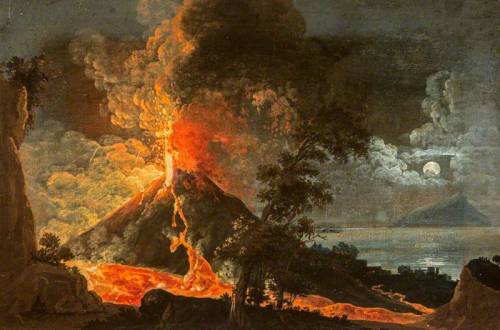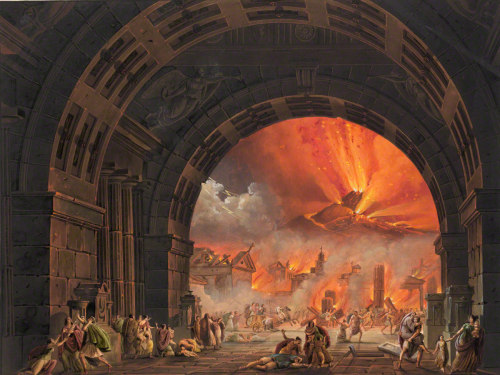italianartsociety:By Samantha Hughes-Johnson.On this day in history (24 August, 79 A.D.) Mount Vesuv
italianartsociety:By Samantha Hughes-Johnson.On this day in history (24 August, 79 A.D.) Mount Vesuvius erupted, killing around sixteen thousand individuals who lived and worked in various locations within the Bay of Naples. Gaius Plinius Luci filius Caecilius Secundus, otherwise known as Pliny the Younger, detailed the natural disaster in a letter to Cornelius Tacitus (the Roman historian and politician).On 24 August, in the early afternoon, my mother drew [my uncle’s] attention to a cloud of unusual size and appearance… it’s general appearance can best be expressed as being like an umbrella pine, for it rose to a great height on a sort of trunk and then split off into branches, I imagine because it was thrust upwards by the first blast and then left unsupported as the pressure subsided…Sometimes it looked white, sometimes blotched and dirty, according to the amount of soil and ashes it carried with it…Pliny the Younger’s uncle, Gaius Plinius Secundus (who was a commander of the Roman fleet at this time) swiftly embarked on a rescue mission and sailed from his base at Misenum across the bay towards Pompeii. [Pliny the Elder] gave orders for the warships to be launched and went on board himself with the intention of bringing help to many more people… for this lovely stretch of coast was thickly populated. He hurried to the place which everyone else was leaving… ashes were already falling, hotter and thicker as the ships drew near, followed by bits of pumice and blackened stones, charred and cracked by the flames…Pliny the Elder attempted to dock however, “the shore was blocked by debris from the mountain,” and he was forced to sail on to Stabiae (a few miles south of Pompeii) and lodge with a friend there.Meanwhile, on Mount Vesuvius, broad sheets of fire and leaping flames blazed at several points, their bright glare emphasised by the darkness of night… During that evening, the courtyard of the house in which Pliny the Elder was staying began to fill with ash and pumice and “the buildings were now shaking with violent shocks, and seemed to be swaying too and fro, as if they were torn from their foundations.” Outside of the house, the situation was perhaps even more lethal, with chunks of pumice raining down from the skies upon unsuspecting would-be escapees. As dawn broke, Stabiae remained in darkness, the sun blocked by the dust and smoke expelled by the volcano. At this point, Pliny the Elder decided to check on his ship and perhaps evacuate himself, his friend and any other Roman citizens by sea. This plan was not to be brought to fruition however, as the ocean was too rough and Pliny the Elder swiftly succumbed to the polluted air. Collapsing near to his ship, Pliny took his final struggling breath. His body was not recovered until 26 August, “when daylight returned” to Stabiae. According to his nephew, Pliny’s corpse was found, “intact and uninjured, still fully clothed and looking more like sleep than death.”It is thought that the intense heat produced by the eruption in tandem with the dangerous ballistics and the toxic gasses expelled by Vesuvius, killed around two thousand Pompeiians and up to sixteen thousand people in total. References: Pliny the Younger, The Letters of Pliny the Younger, trans. Betty Radice, London: Penguin Books, 1963, pp. 166-169. https://www.history.com/topics/ancient-history/pompeiiImages: Attr. Pietro Antoniani, An Eruption of Vesuvius, seen from the Atrio del Cavallo, 1780-1790, oil on canvas, National Trust Collection. Wikimedia Commons. Carlo Sanquierico, The Eruption of Vesuvius from Pacini’s The Last Day of Pompeii, 1827–32, hand-colored aquatint, The Getty Research Institute, Los Angeles. Wikimedia Commons. -- source link
Tumblr Blog : italianartsociety.tumblr.com

